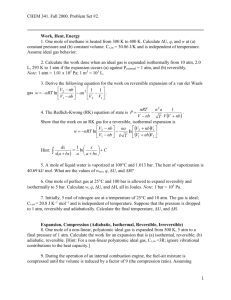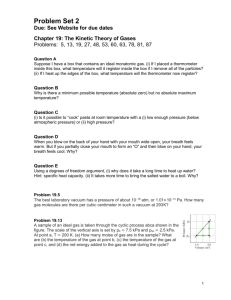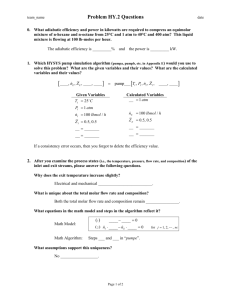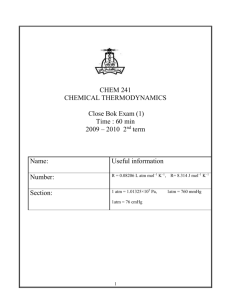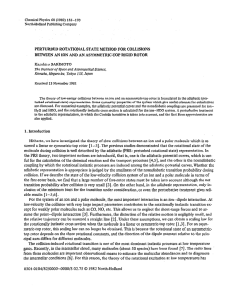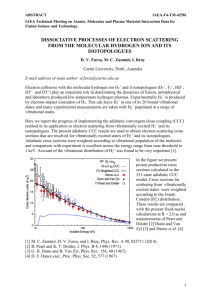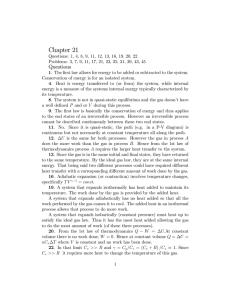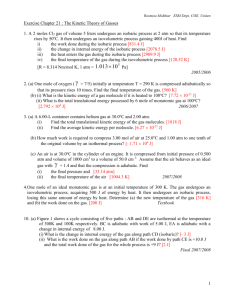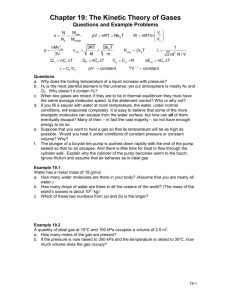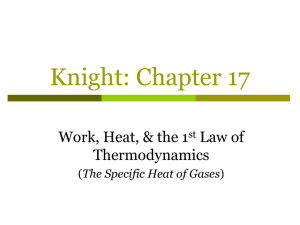Thermal Physics Lab Experiments Guide
advertisement
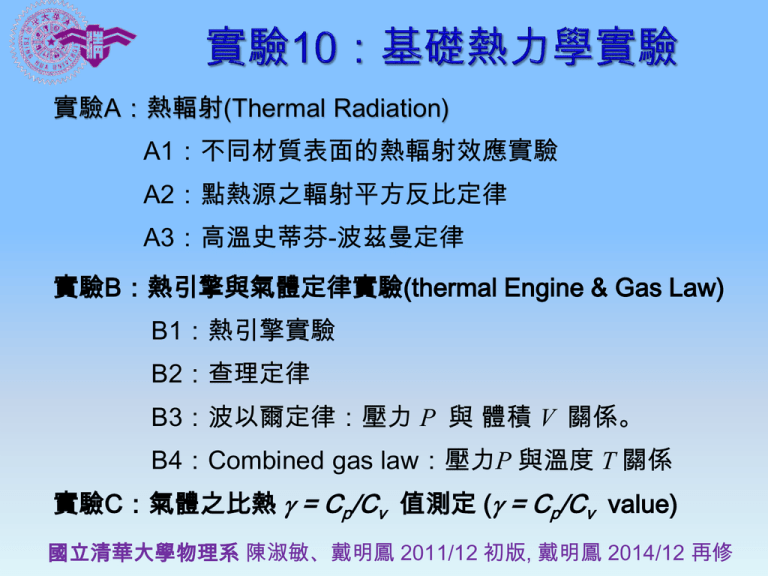
實驗A:熱輻射(Thermal Radiation) A1:不同材質表面的熱輻射效應實驗 A2:點熱源之輻射平方反比定律 A3:高溫史蒂芬-波茲曼定律 實驗B:熱引擎與氣體定律實驗(thermal Engine & Gas Law) B1:熱引擎實驗 B2:查理定律 B3:波以爾定律:壓力 P 與 體積 V 關係。 B4:Combined gas law:壓力P 與溫度 T 關係 實驗C:氣體之比熱 = Cp/Cv 值測定 ( = Cp/Cv value) 國立清華大學物理系 陳淑敏、戴明鳳 2011/12 初版, 戴明鳳 2014/12 再修 實驗A 、B輪流組別 同一顏色區塊為相互輪流組別 熱水瓶使用分配 紅色為熱水瓶放置位置 實驗C:僅三套實驗設備,分別使用He,一般 空氣和CO2作為工作氣體。各組輪流操作。 1. 觀察熱輻射現象:物體表面材質、顏色、粗 糙度和熱源溫度對熱輻射的影響。 2. 驗證點熱源平方反比定律:熱輻射強度與距 離的關係。 3. 驗證史蒂芬-波茲曼定律:熱輻射強度與溫度 的關係。 史蒂芬-波茲曼輻射定律(Stefan-Boltzmann Radiation Law) 1. 何謂史蒂芬-波茲曼輻射定律? 2. 此定律的適用範圍? 3. 一般室溫環境內的該輻射定律的主要公式為何? 物體性質和環境溫度對熱輻射的影響 1. 預測物體表面材質、顏色、粗糙度(roughness)和 2. 環境溫度對熱輻射的影響 1.熱輻射體 1台 7. 毫伏特計(電表電壓模式) 1台 2.熱感應器 1組 8. 歐姆計(電表電阻模式) 1台 3.隔熱手套 1套 9. 電流計(電表電流模式) 1台 4.隔熱板 1片 10. 電源供應器 1台 5.長尺 1支 11. 史蒂芬—波茲曼燈泡 1組 6.玻璃 1片 結構:鋁製腔體有四面經不同處理的表面:(1)精密拋光的鋁 面、(2)噴砂處理的鋁面,(3)噴黑漆的面、(4)塗成白色的面。 使用方法:量測腔體內部的熱電阻值,再根據換算表換算腔 體內之燈泡溫度 感應器前端的兩凸出端點作用為 (1)避免感應器和輻射源太過接近 (2)固定感應器到熱輻射源的相對距離。 注意:感應器不使用時須將遮罩關閉。 可使用隔熱板代替。 注意:燈泡之電壓勿超過 13V,否則會燒壞 使用方法: 1. 藉由調整輸入燈泡兩端的電壓,可使燈絲的溫度上 升到接近3000℃; 2. 輸入的最大電壓值為13 V,最小電流量為2 A,最 大電流量為3A。 1.打開熱輻射體的電源,預熱燈泡。 2.將功率調到5.0,當熱輻射體達到熱平衡時,即可開始量測。 等待熱平衡的時間長(約20~30分鐘),可同時做下一個實驗。 1.燈泡未輸入電源前,記錄背景輻射量。 2.打開直流電源供應器,輸出10V定電壓(不可超過13 V)。 3.改變熱感應器與燈泡間的直線距離,記錄在不同距離時, 熱感應器偵測到之輻射強度。 1.加熱燈泡前,先量測室溫及燈泡的電阻Rref。 2.打開電源供應器,輸出1 V的定電壓。測量熱感應器偵測到之 電壓,並記錄電源供應器輸出的電壓V及電流 I。測完後記得將 隔熱板放熱輻射強度回熱感應器和燈泡之間。 3.改變加熱燈泡的定電壓值(勿超過13 V),重複上述步驟。 1. 熱引擎實驗:藉著完成熱力循環的過程, 令氣體對 砝碼做功, 進而了解一些熱力過程及熱引擎的原理。 2. 查理定律:驗證體積V 與溫度 T 的關係。 3. 波以爾定律:驗證壓力 P 與體積 V 的關係。 4. Combined gas law :驗證壓力P與溫度T的關係。 1. 熱引擎作功原理 2. 何謂波以爾定律? 體積 V 與溫度 T 間關係? 3. 何謂定容及定壓之查理-給呂薩克定律? 熱引擎設備不可浸在任何液體中。 實驗完畢或不用時,一定要將連接管夾鬆開,避 免造成永久性變形。 a→b:將200g砝碼放在活塞平台上,記錄b點的溫度。 b→c:將氣瓶從冷水移到熱水中,記錄c點的溫度。 c→d:將200g砝碼移開,記錄d點的溫度。 d→a:將氣瓶從熱水移回冷水中,記錄a點的溫度。 注意事項: 1.熱水從熱水瓶中取水,水量為可浸滿氣瓶即可,熱水 瓶三組共用一台,請依照分組號碼取水。 2.注意熱水瓶水位,若快取用完畢請通知助教加水避免 空燒。 3.在裝置完成後,空氣即已完成密閉,不可再強拉或壓 活塞。 4.實驗時,將長型抹布墊在冷熱筒下方,避免溢出的水 灑滿桌面。實驗中若水不小心溢出,請隨時擦乾桌面。 在熱筒裡加入適量冷水,至少調配出5個溫度。 注意事項:調配各種溫度時,每次加入少許冷水即可,若不小 心水太滿須倒出,可先倒在集水桶裡。 1.將熱引擎活塞拉到最高的位置, 將壓力感應器接上管路的接 口,將另一端的管路夾壓緊。 2.利用砝碼將活塞往下壓,記 錄不同壓力下相對應的體積 (砝碼最多加到200g)。 將氣瓶接上壓力感應器,放 入熱筒裡,在熱筒裡加入適 量冷水,至少調配出5種溫度, 記錄相對應的壓力。 注意事項: 實驗完畢後務必 將集水桶的水倒入水槽,桌 子擦乾並擰乾抹布,將抹布 披在桌子上。 一、實驗目的: 探討氣體在絕熱過程 d𝑄 = 0 下,氣體壓力 P 與 體積 V 的關係為 𝑝𝑉 𝛾 = 常數, 其中 𝛾 ≡ Cp Cv , γ 和氣體分子之結構的自由度及絕熱過程關係密 切,是氣體動力學上一個很重要的係數。 二、實驗原理: 定溫下,定量的理想氣體的壓力 P 和體積 V 乘積為定值, 即 PV ~nRT ~定值 此稱「波義耳定律」。 但氣體不是良好的熱導體,需要足夠的時間才能達到溫度熱平衡。 故當 P和V 改變過快時(如:音波的傳導),氣體各部分之間可能來不及 交換熱量,因此,實際發生的過程不可能是等溫變化,甚至可能是應 當作絕熱過程(adiabatic process)。 絕熱過程和等溫過程的不同處在於: 1. 絕熱過程中,氣體如果被壓縮,外界對它所作的功全部變為氣體的 內能,因此氣體的壓力和溫度同時升高。 2. 但若氣體膨脹,氣體也會對外界作功而消耗內能,因此氣體的壓力 和溫度同時降低。 由此可知:在絕熱過程中, P 隨 V 的變化率必定較等溫過程明顯,即 P –V 曲線必定較陡峭。 An adiabatic process: no energy is transferred by heat between a system and its surroundings. All three variables in the ideal gas law (P, V, T) can change during an adiabatic process. Assume an ideal gas is in an equilibrium state PV = nRT is still valid. The relation of P and V of an ideal gas at any time during an adiabatic process: PV = constant. where = CP / CV is assumed to be constant during the process. Section 21.3 25 An adiabatic expansion of an ideal gas. The temperature of the gas decreases Tf < Ti Equations of state of this process PiVi = PfVf TV –1 = constant = CP / CV 26 Section 21.4 27 Q: Air at 20.0oC in the cylinder of a diesel engine is compressed from an initial pressure of 1.00 atm and volume of 800.0 cm3 to a volume of 60.0 cm3. Assume air behaves as an ideal gas with g = 1.40 and the compression is adiabatic. Find the final pressure and temperature of the air. Solution: Vi 800.0 cm3 Pf Pi (1.00 atm) 3 V 60.0 cm f Pf V f PV i i Ti Tf 1.40 37.6 atm (37.6 atm)(60.0 cm3 ) Tf Ti (293 K) 3 PV (1.00 atm)(800.0 cm ) i i Pf V f 826 K 553 C 28 With complex molecules, other contributions to internal energy must be taken into account. One possible energy is the translational motion of the center of mass. The center of mass can translate in the x, y, and z directions. This gives three degrees of freedom for translational motion. Section 21.4 29 Rotational motion about the various axes also contributes. ◦ Neglect the rotation around the y axis since it is negligible compared to the x and z axes. ◦ Ideally, if the two atoms can be modeled as particles, Iy is zero. Rotational motion contributes two degrees of freedom. Section 21.4 30 The molecule can also vibrate. There is kinetic energy and potential energy associated with the vibrations. The vibrational mode adds two more degrees of freedom. Section 21.4 31 Taking into account the degrees of freedom from just the translation and rotation contributions. Eint = 5/2 nRT CV = 5/2 R Be in good agreement with data for diatomic molecules CP = 7/2 R = 7/5 = 1.40 However, the vibrational motion adds two more degrees of freedom . Eint = 7/2 nRT & CV = 7/2 R = 9/7 This is inconsistent with experimental results. Section 21.4 32 Molar specific heat is a function of temperature CV(T). (1) At low temperatures: a diatomic gas acts like a monatomic gas. CV = 3/2 R (2) At about room temperature: the value increases to CV = 5/2 R. - Be consistent with adding rotational energy but not vibrational energy. (3) At high temperatures: the value increases to CV = 7/2 R. This includes vibrational energy as well as rotational and translational. 33 Section 21.4 34 For molecules with more than two atoms, the vibrations are more complex. 2. The number of degrees of freedom is larger. 3. The more degrees of freedom available to a molecule, the more “ways” there are to store energy. 1. This results in a higher molar specific heat. Section 21.4 35 ---Verner版本 201312_瑜 氣體絕熱測量儀 LabQuest mini (數據處理盒) Loggerpro (軟體) 將絕熱量測儀與LabQuest mini連接後與電腦連接。 1.將各感應器信號與軟體連接 1.將游標移至紅框處校正感應器 1.校正壓力感應器: 電壓與壓力換算方程式如下 1. 1.2. 1.4. 1.1 2. 體積感應器免校正:直接讀取電壓值 (於表單內依高度與電壓 的關係換算) 3.校正溫度感應器: 電壓與溫度依單點校正 3. 3.3 5 3. 3.2 3.1 3. 4. 3.6 填上現在溫 度 (K),按保留 3. 7 4.確認溫度,壓力讀值正確 5.新增體積欄位 ,依15cm處及6cm對應之 電位做線性fitting, 將方程式並體積換算 鍵入 (圓管直徑4.45cm) 103.3 6.清除之前測試數據 7. 實驗: run(取樣) &迅速下壓橫桿,STOP 6. 1 6.2 7. 1 7. 3 7.2 8.新增LnV及LnP欄位,繪出LnV vs.LnP關係圖並做線性擬合 9.數據結果是否符合預期? 10.匯出數據


